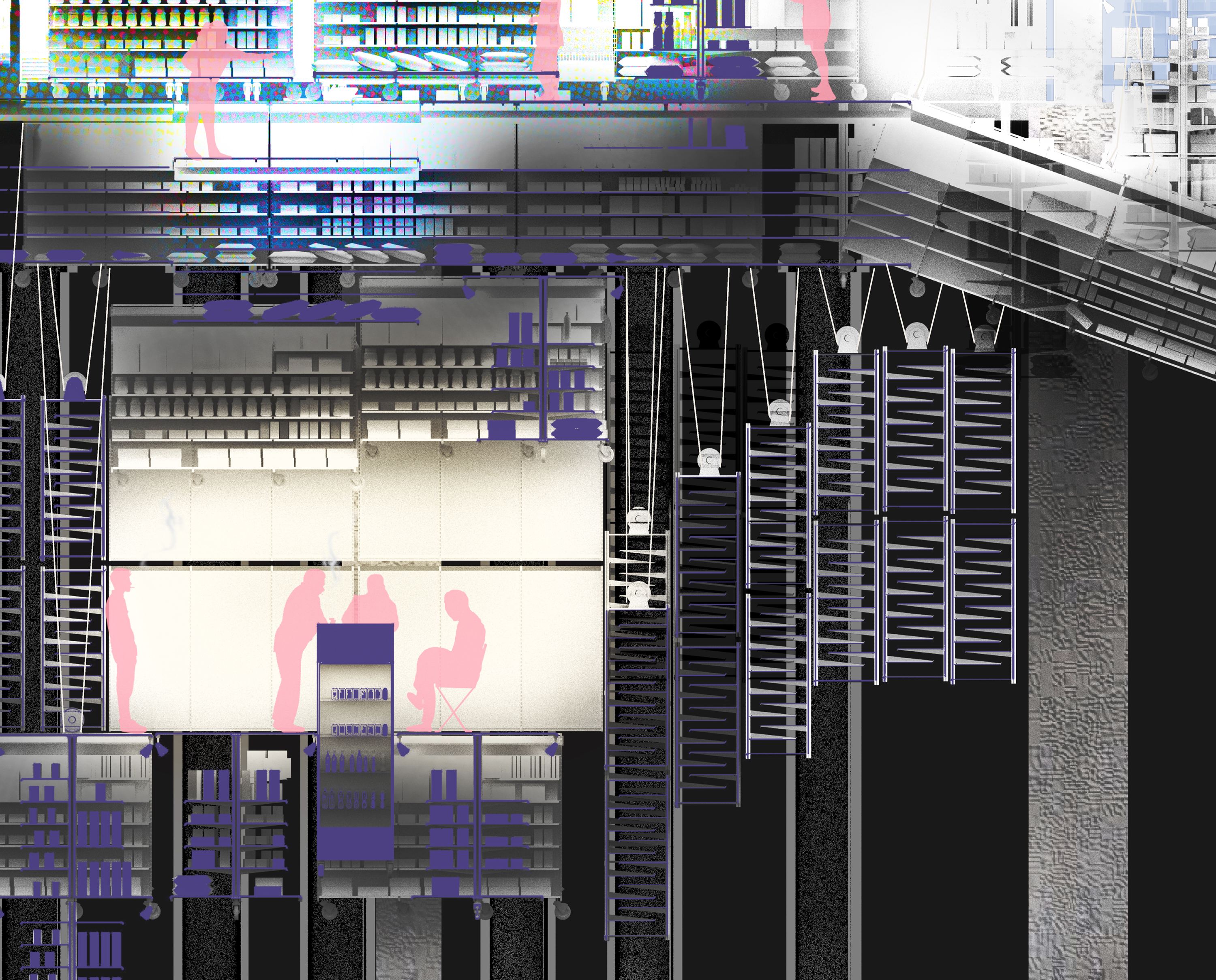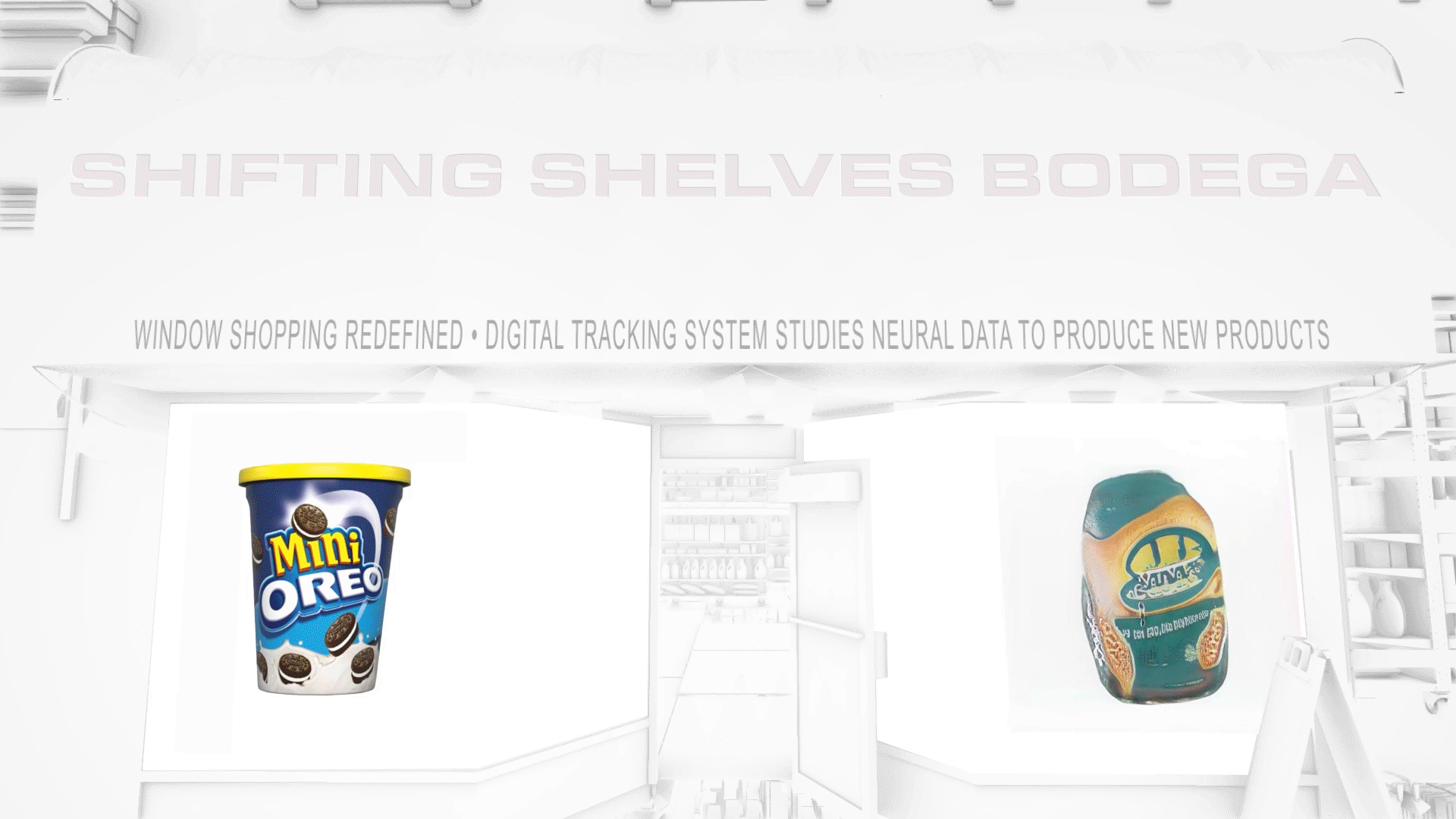SHIFTING SHELVES
Bodegas in Brooklyn stock their shelves so full and so tight that an illusion of infinity occurs- their products go on and on, and they appear to have everything you need. Global scale digital operations threaten to upend these independent convenience stores, though. Amazon is able to provide a much wider array of products by drawing from enormous warehouses and employing complex delivery networks. Though they cram as much as they can into their 17x50 foot spaces, bodegas simply can’t keep up. Or can they?
What if bodegas begin to operate with digital corporate logics to subvert those systems and keep Brooklynites coming back to local, immigrant owned businesses? Their stocked-shelf system gets blown up to an unruly proportion, with the walls, floors, and ceiling becoming shelves. An entire building gets bought out, gutted, and infilled with a structural system that reorganizes shelves on the fly. The façade is left standing to mask the full operation, but glimpses can be caught through the windows of the former apartments. The bodega appropriates data-usage models of big tech companies and incorporates them into the physical realm: customers can sign in to the bodega, which then rearranges the shelves based on algorithms, trends, purchase history, and recommendations to best suit and entice the customer. Remote storage logics are reworked and incorporated through an inter-bodega network. Independent stores can send shelves over to each other, making each store seem as though it has everything and never goes out of stock. Right under the noses of CVS and Walgreens.
 Section
SectionWith this new system of operations, bodegueros are presented with a new opportunity to play up the community aspect of bodegas. Since their development by Puerto Rican immigrants in the 1950s, bodegas have been cultural oases and communal aggregators by and for New York’s immigrant population. Bodegueros, faced with the ability to rearrange shelves, also gain the advantage of, and ability to, rearrange space. Shelves shift to allow for community event spaces, theaters, bridge club meeting rooms, ping pong tournament rooms, gambling dens, and more. The bodega has always been more than just a place to buy an egg and cheese sandwich. But now it’s a place to buy 92% of your day-to-day purchases, and a place to connect with your neighbors in a way Amazon and CVS never have and never will.









As the shelves of the bodega begin to operate like a software, so do the products. A screen fills the exterior window, flashing images of products in stock in rapid succession. A shopper stands and stares while the bodega taps into the shopper’s neural signals, monitoring peaks and valleys. The AI-driven curatorial machine discards the valleys and correlates peaks with the respective products that triggered the stimulation, merges the products, and produces a new product of optimal desirability, redefining window shopping. The process repeats, constantly throwing new products into the image gallery. How long must it run to arrive at a single product everyone (or no one) wants and no one can refuse?
(This project was completed in 2021, thereby predating every now-prevalent AI image generator, including Midjourney, Stable Diffusion, and DALLE. The AI-generated snack images featured in this project were produced in an early version of Runway, which, rather than using a software-scraped set of millions of images and the user’s text-based input, used a series of 300 images of existing snacks hand-selected and arranged by me. The speculations set forth in the project both predicted future conditions (likely outcomes based on an input of a mass of images) and continue to outpace them (actual products derived from the input of thousands of humans’ desires). This is the magic which can happen when working in a “just-on-the-other-side-of-plausible” modality: not a Utopian or Dystopian future, but one that stretches present possibilities just a little farther than seems possible now AI plays no present or future role in my workflow, and I do not use it to help me produce ideas, images, or text.)
(This project was completed in 2021, thereby predating every now-prevalent AI image generator, including Midjourney, Stable Diffusion, and DALLE. The AI-generated snack images featured in this project were produced in an early version of Runway, which, rather than using a software-scraped set of millions of images and the user’s text-based input, used a series of 300 images of existing snacks hand-selected and arranged by me. The speculations set forth in the project both predicted future conditions (likely outcomes based on an input of a mass of images) and continue to outpace them (actual products derived from the input of thousands of humans’ desires). This is the magic which can happen when working in a “just-on-the-other-side-of-plausible” modality: not a Utopian or Dystopian future, but one that stretches present possibilities just a little farther than seems possible now AI plays no present or future role in my workflow, and I do not use it to help me produce ideas, images, or text.)





